The Western screech owl, also known by the scientific name Megascops kennicottii, is an owl that goes by other monikers. Some other common names for this gorgeous bird include Yuma screech owl, Pasadena screech owl, California screech owl, Kennicott’s screech owl, Guadalupe screech owl, and Vinaceous screech owl.
It isn’t surprising to learn that the name screech owl is taken from their distinctive singing. It’s based on the calls that they make that have a wailing and warbling sound. Their babies are born blind and remain helpless during the first weeks of their lives. These owlets rely on their mom and dad to provide food, shelter, comfort, and warmth.
Right now, I’m going to tell you about a wide range of other critical facts about Western screech owls. I’ll dive deeply into the following topics:
- How to identify Western screech owls
- Interesting factoids about Western screech owls
- Nesting preferences, behavioral habits, migratory preferences, and feeding habits
- The physical differences between male and female Western screech owls
- Other important facts
Find out more about these stunning birds by continuing below.
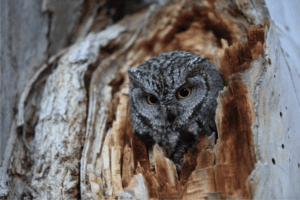
Western Screech Owl Bird Facts
- Common Name: Western Screech Owl
- Scientific Name: Megascops kennicottii
- Scientific Family: Strigidae
- Life Span: 13-19 years
- Size: 7.48 to 10.0 inches
- Wingspan: 6.63 to 6.87 inches
- Weight: 3.1 to 7.8 oz
- Conservation status: Least Concern
How To Identify A Western Screech Owl
Western screech owls tend to blend into their surroundings, which makes them birds that are supremely camouflaged. Their overall base colors include a grayish hue, reddish-brown hue, or brownish hue.
Differences Between Male & Female
Male and female Western screech owls look very similar to one another. They are usually mostly gray with dark streaks upon their chest and white bars upon their wings. They also have white streaks on their shoulders.
The females tended to be bigger and weigh more than their male counterparts. Even though this doesn’t completely indicate gender, males often have brighter feathers.
Differences In Summer Plumage vs Winter Plumage
Western screech owls do not change colors or show plumage differences during different seasons.
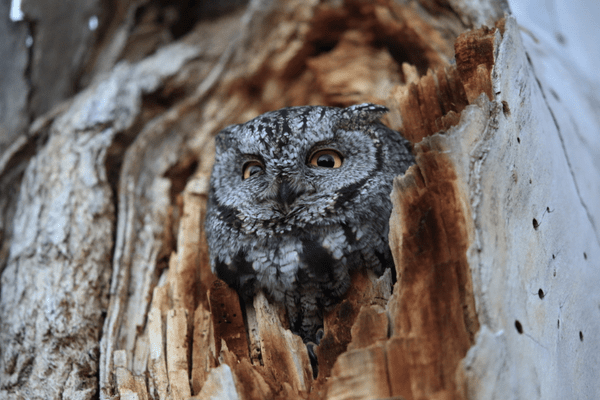
Where You’ll See Western Screech Owls
These small majestic birds tend to make their home in a wide variety of terrain types in the West. You’ll find them in southeastern Alaska in the coastal forests. They also make their homes within the Arizona desert cactus groves. Even more interesting, it’s even possible to find them living in suburban areas.
They prefer living in forested habitats, residential areas and urban parks, backyard nesting boxes, and tree cavities.
Western Screech Owl Migration Patterns
In North America, they make their home in Mexico, and a large portion of Canada, in the southeast they live in Alaska, and they also range throughout Texas from the southern to western borders.
Diet and Feeding Preferences
Western screech owls mostly eat large insects and small mammals. This includes a wide variety of species that live throughout various regions and habitats.
You’ll find these owls preying upon creatures that include pocket gophers, centipedes, voles, spiders, beetles, mice, moths, scorpions, snakes, small birds, fish, frogs, and lizards.
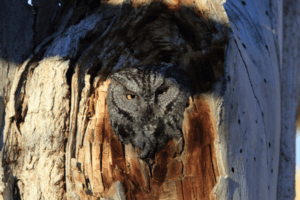
Western Screech Owl Nesting Facts
- Clutch Size: 2-7 eggs
- # of Broods: 1 brood
- Incubation Period: 26-34 days
- Nestling period: 27-35 days
- Egg Description: White
Like other owls, the Western screech owl doesn’t personally build its own nest. It will find a cavity or depression – like the hollow of a tree for example – and use it to lay eggs. It will not even bring its own material into the cavity, but instead, it uses whatever is already available.
Western screech owls typically occupy a cavity that’s roughly 1 foot in diameter and only a foot and a half deep. The entrance is large enough to allow the owl’s body to fit in the cavity, but that’s about all.
It’s assumed that Western screech owls prefer small cavities in an effort to keep out larger predators.
Western Screech Owl Behavior
The feeding behavior of the Western screech owl is that it likes to hunt at dusk and it also hunts at night. Typically, this bird will wait and watch for predators to enter its territory.
It will then swoop down and catch its prey and its talons by lifting it off the ground or picking it up from the foliage. The screech owls in the West also like to catch insects as they are flying through the air. Even more interesting, they hunt predators by sight and sound.
The Western screech owl isn’t afraid to aggressively defend its nest. In fact, if human beings are encroaching upon its nest or territory, this owl will potentially attack. And it will aggressively defend its nest against any and all potential predators.
The Western screech owl is specifically known as a nocturnal creature. During the day, it will spend its time inside of its nest hole or it will roost. On occasion during the day, you can find this owl with its head peeking out of its entrance hole enjoying the sun as it beams down on its face.
This bird is also known as a socially monogamous owl. Screech owls will pair off and remain monogamous with their partner. They will even raise their young owlets together. Although, it’s known that either mail or females will meet outside of their monogamous pairing from time to time.
Preening together is also an important part of the Western screech owl’s self-care routine. The male will preen the female partner and the female will preen the mail and return.
The mating ritual has the male screech owl bringing food to the female during the courtship process. They will also sing duets together, which creates very beautiful music.
While their breeding season is taking place, the male will roost very close to the nest cavity. And as the last few weeks of nesting are happening, the female will suddenly leave the nest but roost very close to her male partner, even touching bodies together.
The adult male and female Western screech owls take their jobs of guarding the entrance to their nest very seriously. They protect the nest vigorously and aggressively from jays, crows, and other potential predators.
During nesting, the male will also provide food to the young owlets and the female. The female will remain with her young owlets for the first three weeks. But as time moves on, she will take breaks from the nest to hunt with her male partner.
Young owlets in the Western screech owl family typically leave the nest before they have gained the ability to fly. They will remain close to their parents for roughly 5 weeks upon leaving the nest.
Tips for Birdwatchers On How To Attract Western Screech Owls
Putting up a nesting box is one of the best ways to attract a pair of male and female Western screech owls. The best time to install the nesting box is far in advance of the breeding season. Breeding season takes place from late April through late May, but the owls will potentially begin occupying nesting boxes by mid-March.
Adding a water source is also another great way to attract Western screech owls and other owls for that matter. Since this version of the screech owl is on the smaller side, the birdbath doesn’t need to be particularly large in this case. But make sure the water source is big enough to provide ample room for the owls to bathe, drink, and luxuriate in the water.
Feeding on prey is always of the utmost importance to Western screech owls or any other bird species for that matter. To create an attractive environment with lots of available prey, it’s best to keep the grass on the longer side. This will attract more mice and other small mammals that the Western screech owls can catch and eat as food.
Having lots of insects and reptiles in your backyard is certainly a great way to attract screech owls and other birds as well. So, make sure your environment is conducive to attracting reptiles and insects when appropriate and this should lead to more Western screech owls nesting in your backyard.
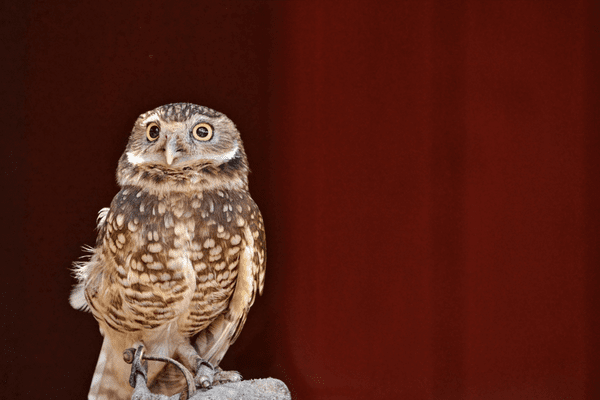
Conservation Status
The conservation status of this owl is considered Least Concern. This means that the population isn’t in danger of becoming extinct. In fact, it’s estimated that the overall Western screech owl population consists of 180,000 owls.
Although, the Western screech owl population in the Pacific Northwest has recently become vulnerable. The barred owls arrived in their territory not that long ago due to clearcutting, which has caused a negative impact on the overall number of Western screech owls in existence.
Fun & Interesting Facts
- Before breeding begins, the male Western screech owl will present food to its female mate. The male also initiates courtship displays of an elaborate nature to impress and attract the female. This consists of a sort of dance of hopping, bill snapping, and bowing.
- This owl is considered a “sit and wait” predator. This means it will remain perched on its roost while waiting for predators to arrive in its territory. They initiate their foraging activities immediately prior to sunset.
- The ideal nesting location for these owls consists of man-made nesting boxes or tree cavities. They do not prefer nesting in other potential nests unless absolutely necessary.
- These creatures will live in a wide variety of habitats. But the most important thing is that wherever they choose to live, it should have plenty of bushes, fruit tree orchards, forests, and deserts. It’s quite possible that a family of Western screech owls will also move into your neighborhood.
- They do not like to live in the mountains are on hills. They like taking over nests inside the hollows of trees. Occasionally, they will even take over the former nest of a family of woodpeckers.
- Out of all of the owls in North America, the Western and Eastern screech owls are the smallest in size and stature. They readily puff out their plumage to make themselves look scarier and bigger when larger predators are threatening their home or family.
Explore More Species in This Family
- White-throated screech owl
- Bare-shanked screech owl
- Foothill screech owl
- Alagoas screech owl
- Yungas screech owl
- West Peruvian screech owl
- Long-tufted screech owl
- Choco screech owl
- Balsas screech owl
- Xingu screech owl
- Rufescent screech owl
- Vermiculated screech owl
- Pacific screech owl
- Tawny-bellied screech owl
- Whiskered screech owl
- Santa Marta screech owl
- Black-capped screech owl
- Cinnamon screech owl
- Middle American screech owl
- Bearded screech owl
- Tropical screech owl
- Koepcke’s screech owl
- Cloud-Forest screech owl
- Eastern screech owl
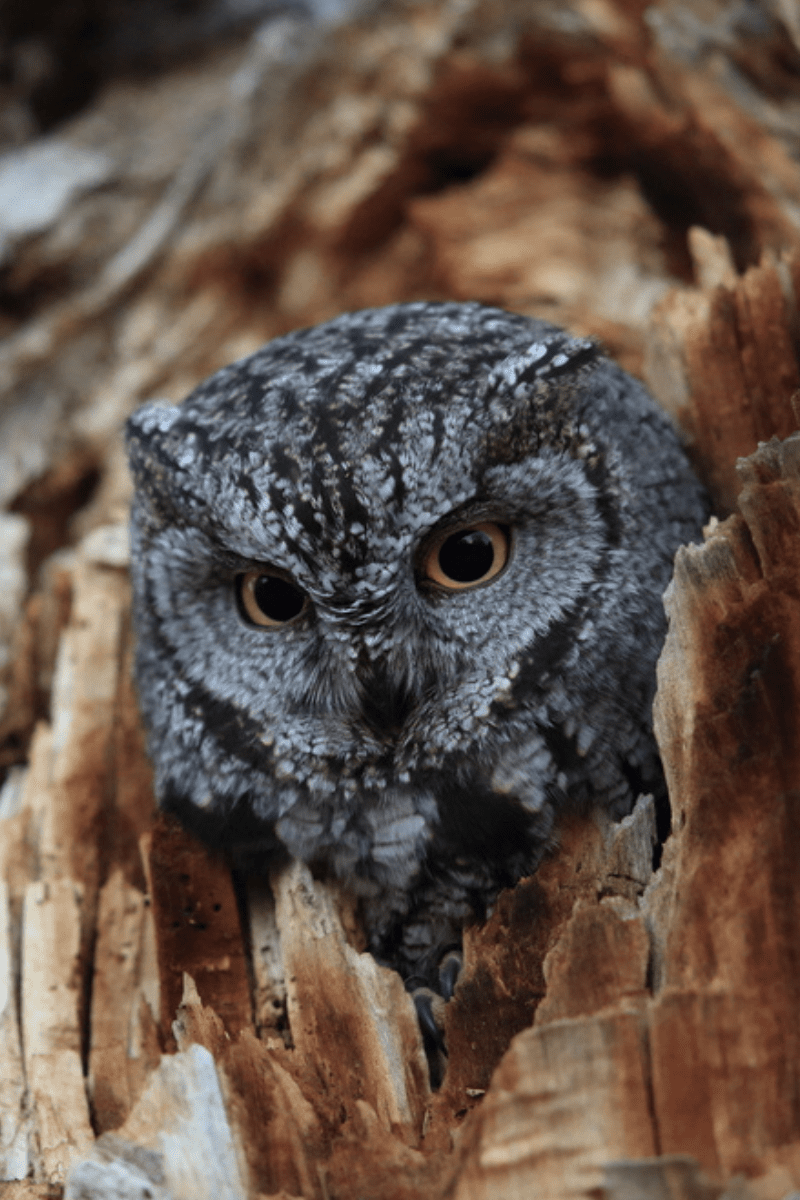
from BirdInformer.com https://ift.tt/QTkgu6d

No comments:
Post a Comment